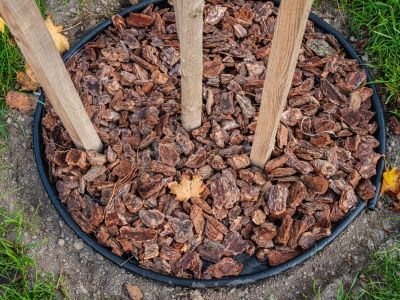Care for Newly-Planted Trees
What is a landscape without landscape trees? Shade and ornamental trees made a backyard more beautiful and more functional. And installing young trees isn’t cheap, so it’s best for the pocketbook not to have to replant. That’s why it’s important to provide the best possible care for the first few years after planting to give them the best chance to thrive. Some plants, including mature trees, thrive on benign neglect. But newly-planted trees are not among them. Young, newly installed landscape trees require active and regular care during the period from planting until establishment. Count on 12 months of establishment period for every inch of trunk diameter. A young tree with a 3-inch (7.6 cm.) trunk will need 36 months of care. Excellent cultural care during this period helps minimize transplant stress.
Should You Mulch Newly-Planted Trees?
Most gardeners are familiar with mulch: material layered over the soil surface to keep down weeds, regulate soil temperature and hold in moisture. Organic mulch can also ameliorate soil conditions as it disintegrates, improving soil structure, replenishing nutrients, and increasing fertility. Mulching mimics a forest environment in the wild, where last year’s leaves cover the soil. Mulch is material placed over the soil surface. What type of material? There are many options and most fall into two categories: organic and inorganic. Organic mulch materials are made of something that was once alive, and include compost, manure, dried leaves and shredded bark. Inorganic mulch – like plastic or stones – will not decompose into the soil so it offers fewer benefits to newly planted trees.
Mulching Trees in Fall
Experts agree that the best times to plant perennials are spring and fall, with fall planting holding a slight edge for deciduous woody plants. This is because the trees have more time to develop a root system before spring. Fall rains are also a factor. To best assist your young trees through the winter, use organic mulch and apply a layer between 2 and 4 inches (5 and 10 cm.) deep. Don’t go deeper than this or you might attract rodents. Coarse-textured mulch like chopped bark is best since it aerates the soil. Mulch a generous area, at least 2 feet (61 cm.) in diameter and ideally larger. Organic mulches are preferred since they tend to aerate the soil. But don’t take the mulch right up to the tree. Keep it 6 inches (15 cm.) from the trunk and don’t cover the root flare.
Moisture Is Key
Lack of irrigation is one of the main causes of transplant shock, and even some established trees don’t take well to drought. So while mulch helps hold in moisture, you need to be certain that moisture is there to begin with. To figure out when more water is required, check to see if the tree’s root ball is dry. If it has begun to dry out, add water. Use a soaker hose to apply water slowly, giving it time to sink in. Tree watering bags also work well to give the root zone of the tree a slow and thorough soaking in the original root ball. However, as roots grow into the surrounding soil, additional watering techniques will need to be used to wet the entire root zone.
